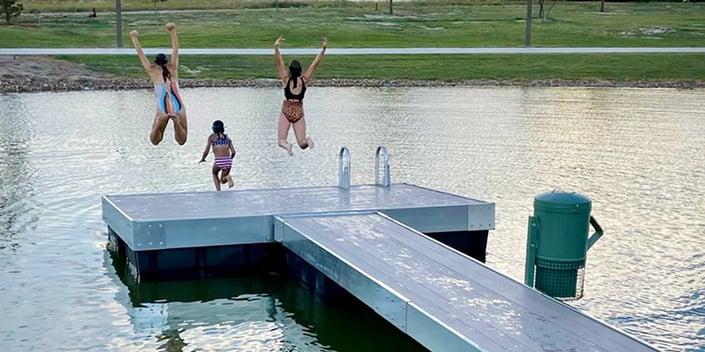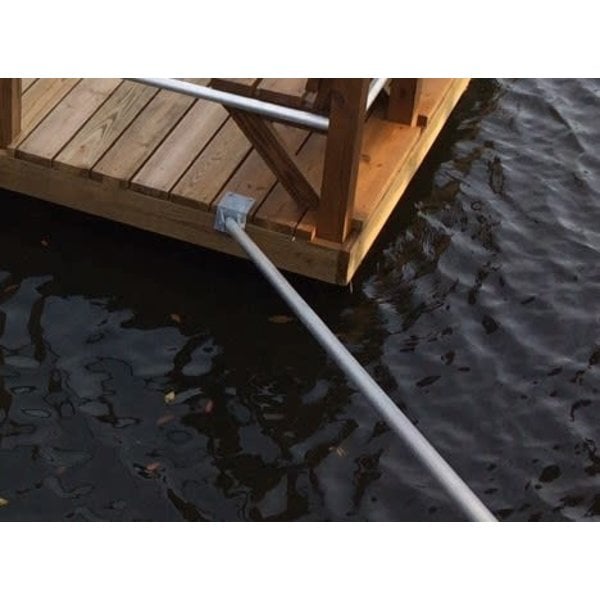Maximizing Your Outdoor Area with Specialized Floating Dock Solutions
Wiki Article
Produce the Perfect Docking Option With Floating Docks
Floating docks existing a versatile option for a variety of maritime requirements, adapting flawlessly to fluctuating water levels and diverse vessel kinds. Their modular nature enables quick setup and relocation, yet the option of suitable materials and design features is crucial for guaranteeing both performance and visual allure. As we check out the crucial elements that add to the effectiveness of floating docks, a number of essential variables pertaining to stability and upkeep will certainly arise, questioning concerning just how to maximize your docking experience. The succeeding conversation will certainly brighten these vital factors to consider.
Advantages of Floating Docks
Floating docks deal countless benefits that make them a perfect choice for different maritime applications. One of the main advantages is their adaptability to altering water levels. Unlike fixed docks, floating docks fluctuate with the trend, making sure regular accessibility for vessels. This attribute is specifically vital in areas susceptible to substantial tidal fluctuations or seasonal water degree changes.Additionally, floating docks are generally much easier and quicker to set up compared to conventional fixed frameworks. Their modular style permits uncomplicated setting up and disassembly, promoting maintenance and relocation when needed. This versatility is specifically helpful for momentary applications or in environments where problems may change.
Floating docks likewise often tend to be a lot more eco-friendly, as they reduce interruption to the seabed and bordering marine ecological communities. Their resilient nature lowers the risk of damages to marine life, promoting a healthier environment. These docks can be tailored to accommodate different vessel dimensions, making sure that they satisfy specific functional demands.
Ultimately, the mix of flexibility, convenience of installation, and ecological considerations makes floating docks a highly efficient service for a vast array of maritime demands.
Selecting the Right Materials
Choosing the ideal materials for floating docks is vital to make sure longevity, long life, and security. The selection of materials directly affects the dock's efficiency in numerous ecological conditions, consisting of direct exposure to water, sunshine, and prospective wear from marine web traffic.Usual products made use of for floating docks include aluminum, timber, and high-density polyethylene (HDPE) Light weight aluminum is light-weight, corrosion-resistant, and calls for marginal upkeep, making it an exceptional selection for long life. Nonetheless, its first price can be higher contrasted to various other materials.
Timber, while visually attractive and giving a traditional appearance, can be at risk to rot and pest damage otherwise appropriately treated. Making use of pressure-treated timber or naturally durable varieties like cedar or redwood can reduce these issues.
HDPE is a preferred option as a result of its resistance to UV rays and chemicals, in addition to being eco-friendly. floating docks. It is readily available and light-weight in various shades, enabling personalization
Ultimately, the appropriate material choice will rely on particular needs, including budget, wanted aesthetic appeals, and environmental considerations. Cautious evaluation of these aspects will cause a successful and durable floating dock remedy.
Style Considerations for Stability
When designing floating docks, ensuring security is an essential facet that can considerably influence their functionality and safety and security. pop over to these guys Stability in floating dock style is influenced by numerous factors, including buoyancy, weight circulation, and the arrangement of components. An optimal buoyancy system ought to a knockout post utilize materials that supply sufficient lift while reducing weight. This equilibrium makes sure that the dock continues to be above water, even under differing loads.Weight circulation is critical; equally distributing loads across the dock avoids tilting and enhances security. Wider styles can supply increased security, especially in rough water conditions, while longer docks might require added supports to avoid sagging.
An additional essential factor to consider is the ecological effect, including wave activity and wind. Integrating attributes such as sidewalls or skirting can assist mitigate the impacts of environmental forces, maintaining security in adverse problems. Inevitably, a combination of thoughtful design, product choice, and understanding of environmental factors will certainly yield a drifting dock that satisfies both stability and safety demands.
Installation Tips and Methods

Following, secure the essential licenses and abide by local laws, which may dictate installation methods and ecological considerations. If required, involve a certified specialist experienced in floating dock installations. Usage high-quality products made for marine settings to improve toughness and long life.
When positioning the dock, align it identical to the coastline to help with simple gain access to. Guarantee that the anchoring system is robust, using cinder block or helical anchors to stabilize the dock versus wind and wave activity. It's crucial to make up seasonal water level fluctuations, including prospective ice activity in colder environments.
Throughout the installation, ascertain the dock's floatation and stability prior to finalizing the anchoring. Regularly examine the installation for any indicators of wear or damages. By complying with these pointers and techniques, you can accomplish a protected, useful, and visually pleasing floating dock setup that meets your demands.
Maintenance and Treatment Standards
Preserving and caring for floating docks is critical to prolonging their life expectancy and making certain secure use. Normal inspections ought to be carried out to identify any kind of indicators of wear, damage, or marine growth. Search for splits, loose fittings, or stained locations on the dock's surface, as these problems can jeopardize structural stability.Cleaning up is important. Utilize a stress washing machine to eliminate algae, barnacles, and particles, which can accumulate in time. For stubborn growth, consider environmentally friendly cleaning agents that won't hurt water life.
Furthermore, inspect the mooring lines and anchors frequently to ensure they are protected and complimentary from deterioration. Change any type of frayed or damaged lines promptly to keep stability.
Throughout severe climate, such as storms or freezing problems, take preventive procedures. Protect the dock with extra mooring lines and, if practical, get rid of any kind of removable components to avoid damages.
Verdict
In verdict, the implementation of More about the author floating docks provides a reliable and versatile docking option suitable for numerous maritime applications. With appropriate installation and regular maintenance, floating docks can supply effective and trustworthy docking experiences for a wide variety of vessels.As we explore the necessary elements that contribute to the effectiveness of floating docks, a number of crucial factors relating to stability and maintenance will certainly arise, elevating questions concerning how to enhance your docking experience. Unlike dealt with docks, floating docks surge and fall with the tide, making sure regular accessibility for vessels.When developing floating docks, making certain stability is an essential element that can dramatically affect their functionality and safety and security. Security in floating dock layout is affected by numerous elements, including buoyancy, weight distribution, and the plan of elements. Eventually, a mix of thoughtful layout, material option, and understanding of ecological variables will certainly generate a floating dock that meets both stability and safety requirements.
Report this wiki page